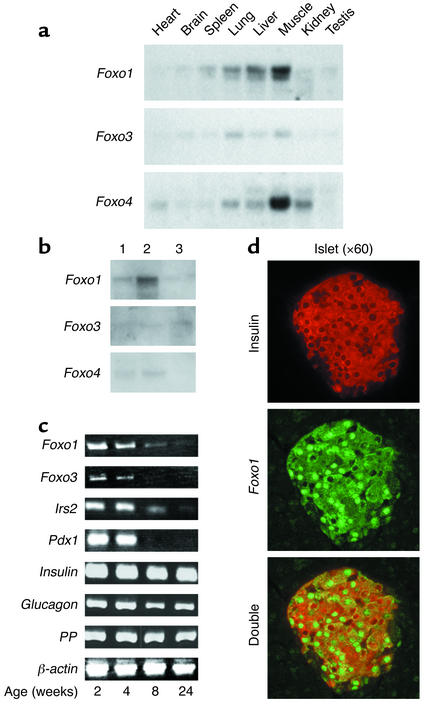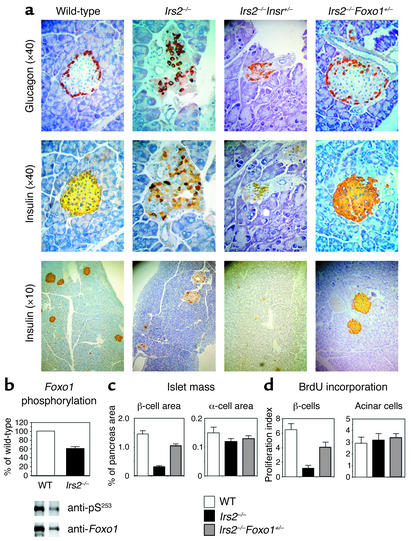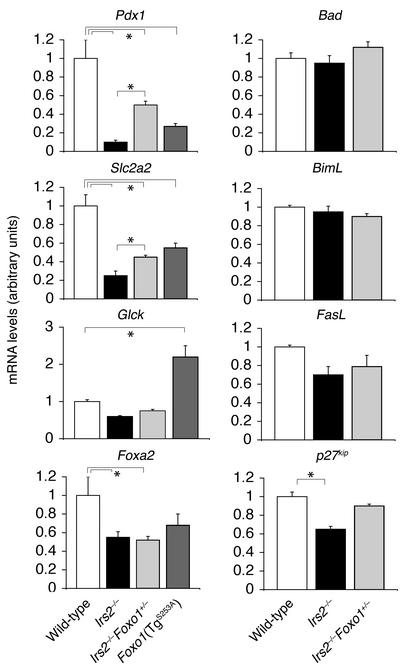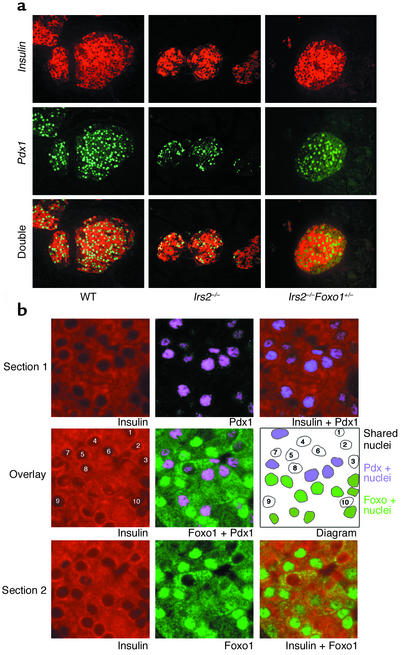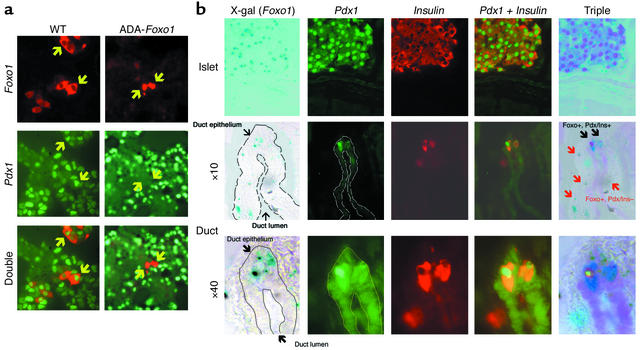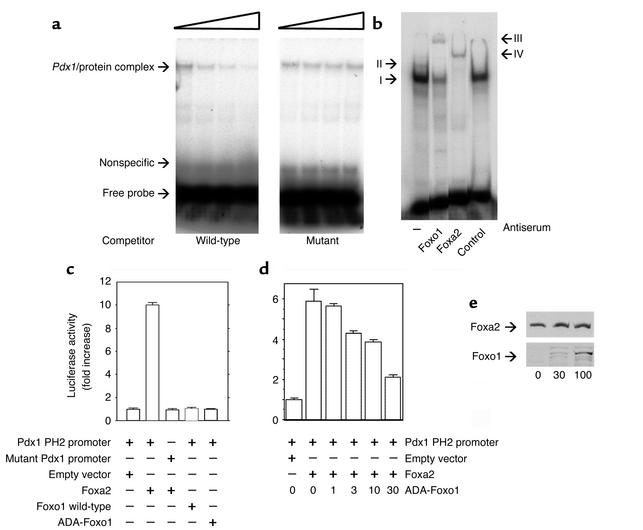Abstract
Diabetes is caused by an absolute (type 1) or relative (type 2) deficiency of insulin-producing β cells. The mechanisms governing replication of terminally differentiated β cells and neogenesis from progenitor cells are unclear. Mice lacking insulin receptor substrate-2 (Irs2) develop β cell failure, suggesting that insulin signaling is required to maintain an adequate β cell mass. We report that haploinsufficiency for the forkhead transcription factor Foxo1 reverses β cell failure in Irs2–/– mice through partial restoration of β cell proliferation and increased expression of the pancreatic transcription factor pancreas/duodenum homeobox gene-1 (Pdx1). Foxo1 and Pdx1 exhibit mutually exclusive patterns of nuclear localization in β cells, and constitutive nuclear expression of a mutant Foxo1 is associated with lack of Pdx1 expression. We show that Foxo1 acts as a repressor of Foxa2-dependent (Hnf-3β–dependent) expression from the Pdx1 promoter. We propose that insulin/IGFs regulate β cell proliferation by relieving Foxo1 inhibition of Pdx1 expression in a subset of cells embedded within pancreatic ducts.
Introduction
Type 2 diabetes results from combined defects of insulin action and pancreatic β cell function (1, 2). Classically, the two abnormalities have been considered as separate entities. However, the recent demonstration that insulin/IGF signaling plays a role in insulin secretion and β cell proliferation has led to a critical reassessment of this view (3). For example, inactivation of insulin receptor (Insr) (4) or IGF-1 receptor (Igf1r) (5, 6) leads to impaired insulin secretion, while inactivation of insulin receptor substrate-2 (Irs2) impairs β cell proliferation (7, 8). These observations indicate that peripheral insulin resistance and β cell failure may share a common pathogenesis. However, the mechanism by which insulin signaling regulates β cell function remains unclear. Forkhead transcription factors of the Foxo subfamily, previously known as Fkhr (9), can promote (10) or repress (11) gene expression. Insulin inhibits Foxo through Akt-mediated phosphorylation and nuclear exclusion, and Foxo1 mutations affect insulin sensitivity in mice (12). Here we report the identification of Foxo1 as an effector of insulin action in pancreatic β cells, and propose a model in which Foxo1 links insulin signaling to regulation of β cell mass.
Methods
Reagents.
We maintained and transfected kidney epithelial cells and β cells according to standard protocols (13). We purchased anti-insulin antibody from Linco Research Inc. (St. Charles, Missouri, USA), anti-Hemagglutinin (12CA5), and anti–5-bromo-2-deoxyuridine (anti-BrdU) antibodies from Sigma-Aldrich (St. Louis, Missouri, USA); anti–c-Myc antibody (9E10) from Roche Molecular Biosystems (Indianapolis, Indiana, USA); anti-Foxo1 and anti–phospho-Foxo1S253 from Cell Signaling Technology Inc. (Beverly, Massachusetts, USA); and anti-Foxa2 monoclonal antibody from the Develop-mental Studies Hybridoma Bank at the University of Iowa (Iowa City, Iowa, USA). We described previously the anti-Foxo1 antiserum used for gel shift assays (13) and the antibody against pancreas/duodenum homeobox gene-1 (Pdx1) (12). Expression vectors and Foxo1 adenoviruses have been described previously (13). All primer sequences are available upon request.
Animal production and phenotypic analysis.
We have described Insr, Irs2, and Foxo1 mutant mice (12). We measured glucose and insulin as indicated in previous publications (12).
Real-time RT-PCR and Northern analyses of gene expression.
We isolated mRNA using the Micro-Fast Track 2.0 kit (Invitrogen Corp., San Diego, California, USA). We carried out Northern blots according to standard methods and semiquantitative RT-PCR using the GeneAmp RNA PCR kit (Applied Biosystems, Foster City, California, USA) with amplification primers corresponding to Foxo1, Foxo3, Foxo4, Pdx1, Irs2, insulin, glucagon, pancreatic polypeptide, and β-actin sequences. We performed real-time PCR using primers encoding insulin 2, Pdx1, Slc2a2, glucokinase (Gck), Foxa2, Bad, Bcl-2 interacting mediator (BimL), Fas ligand (FasL), and p27kip. For these experiments, we isolated mRNA from handpicked islets of similar sizes derived from three 4-week-old animals for each genotype and amplified it using a LightCycler PCR instrument and LightCycler RT-PCR kit (Roche Molecular Biosystems). We carried out each reaction in triplicate using a standard curve with the relevant cDNA for each primer set.
Immunohistochemical and morphometric analysis of pancreatic islets.
We isolated and fixed pancreata from 8-week-old wild-type, Irs2–/–, Irs2–/–Insr+/–, and Irs2–/–Foxo1+/– mice overnight in 2% paraformaldehyde solution, embedded them in paraffin, and immunostained consecutive 5-μm sections for β and α cells using anti-insulin and anti-glucagon antibodies, respective-ly. We performed morphometry using NIH Image 1.60 software (NIH, Bethesda, Maryland, USA) as de-scribed (14). We expressed results as percentage of total surveyed pancreatic area occupied by β and α cells.
Immunofluorescence.
We incubated frozen islet sections with anti-insulin, anti-Pdx1, and anti-Foxo1 antibodies at dilutions of 1:1,000, 1:5,000 and 1:30, respectively. We visualized immune complexes using a CY3-conjugated anti–guinea pig IgG for anti-insulin antiserum, and FITC-conjugated secondary anti-rabbit IgG for anti-Pdx1 and anti-Foxo1 antisera. For colocalization of Foxo1 and Pdx1, we costained two adjacent sections with insulin and Pdx1, or insulin and Foxo1 antibodies, respectively. Thereafter, we acquired images using a SPOT-RT digital camera (Morrell Instruments, Melville, New York, USA) and identified matching islets in the two sections by overlaying the insulin immunostaining. We rendered Pdx1 immunoreactivity as mauve pseudocolor and scored cells in which we could unambiguously identify the nucleus on both sections for either Pdx1 or Foxo1 immunoreactivity. We analyzed a total of ten sections and 50 islets from three mice for each genotype. We fixed transfected βTC-3 cells in 2% parafor-maldehyde and permeabilized them in 0.2% Triton X-100 for immunofluorescence as described previously (13). We visualized endogenous Pdx1 with anti-Pdx1 polyclonal antibody and FITC-conjugated anti-rabbit IgG. We detected transiently ex-pressed c-Myc–Foxo1 in the same sections with a monoclonal anti–c-Myc antibody followed by CY3-conjugated anti-mouse IgG.
Detection and quantitation of β cell replication.
We injected BrdU intraper-itoneally (0.1 g/kg) into 2-week-old wild-type, Irs2–/–, and Irs2–/–Foxo1+/– mice. After 4 hours, we removed and fixed pancreata in PBS (pH 7.4) containing 2% paraformaldehyde and embedded them in paraffin. We immunostained the sections with mouse anti-BrdU antibody (1:1,000). We incubated the sections sequentially with biotinylated anti-mouse IgG reagent (Vector Laboratories Inc., Burlingame, California, USA), VECTASTAIN Elite ABC reagent and DAB (Vector Laboratories Inc.) for visualization. For double staining with anti-BrdU and anti-insulin antibodies, we used a guinea pig anti-insulin antibody. We performed quantitation of β cell and acinar cell replication by counting cells in more than 50 islets stained with anti-insulin antibody for each genotype (for BrdU-labeled β cells) and more than 50 different exocrine fields for each genotype (for BrdU-labeled exocrine cells). We expressed the results as a “labeling index,” i.e., percentage of total cells in surveyed islets and exocrine fields that were BrdU-positive.
Luciferase and secreted alkaline phosphatase assays.
The sequence used for these experiments spanned nucleo-tides –2,233 to –2,097 of the Pdx1 promoter and includes a single consensus forkhead binding site (15). We carried out cotransfections in βTC-3 cells at 70–80% confluence with Pdx1/lucifer-ase reporter gene (pGL3-PDX1-PH2) and control pCMV5 vector or pCMV5-Foxa2, pCMV5–ADA-Foxo1, and pCMV5–wild-type Foxo1. We used secreted alkaline phosphatase (SEAP) (20 ng) as a control for transfection efficiency. We measured luciferase and SEAP activity according to the manufacturer’s specifications (Great EscAPe SEAP kit; Clontech Laboratories Inc., Palo Alto, California, USA). In cotransfection experiments, we added recombinant adenovirus encoding ADA-Foxo1 to cells at different moi’s 12 hours after transfection with Foxa2. Forty-eight hours later, we determined luciferase activity in triplicate samples and normalized it by SEAP activity.
Gel shift assays.
We isolated nuclei of LLC or βTC-3 cells by sequential extraction in NaCl (16). In some experiments, we transduced cells with Foxo1 adenovirus 48 hours prior to nuclei isolation. We incubated double-stranded 32P-labeled oligonucleotide probes (20,000 cpm; 5 fmol) corresponding to the consensus forkhead binding region in the Pdx1 PH2 domain (5′-AGTGCTAAGCAAACATCCTG-3′) with nuclear extracts for 20 minutes at room temperature in the presence of 10 mM Tris-HCl (pH 7.5), 50 mM NaCl, 1 mM MgCl2, 0.5 mM EDTA, 4% glycerol, 0.5 mM DTT, and 100 ng of poly(dI-dC) × poly(dI-dC). For competition experiments, we used either the wild-type oligonucleotide indicated above, or a mutant oligonucleotide: 5′-AGTGCTAcGCcggtgTCCTG-3′ (mutant nucleotides are in lower case). The concentrations of cold competitor used were 0, 100-, 300- and 900-fold excess for both wild-type and mutant probes. We resolved the DNA/protein complexes on 6% nondenaturing polyacrylamide gel and visualized them by autoradiography. For supershift experiments, we incubated anti-Foxa2, anti-Foxo1, or nonimmune sera with nuclear extracts for 10 minutes at room temperature. We incubated competitor wild-type and mutant probes in the reaction mixture for 10 minutes prior to the addition of the radiolabeled probe.
Results
RNA expression studies indicate that the three Foxo isoforms differ with respect to tissue localization, with Foxo1 representing the predominant mRNA isoform in liver (17), lung, and spleen, and Foxo4 in heart, skeletal muscle, and kidney (13). Foxo3 mRNA distribution mirrored that of Foxo1, albeit at lower levels (Figure 1a). Foxo1 is also the main member of the Foxo subfamily in cultured β cells (βTC-3 line) (Figure 1b, lane 2) and murine islets. Its levels decline over the first 6 months of life, as do Irs2 and Pdx1 levels. Foxo3 is expressed at lower levels and Foxo4 is undetectable in islets (not shown). Although a decrease in Pdx1 expression with age has been reported in rat islets (18), the present observation suggests that the downregulation of Pdx1 mRNA occurs earlier than previously thought. It re-mains to be seen, however, whether this is a specific difference between rats and mice or a reflection of interstrain variability in mice. Immunohistochemistry of pancreatic islets with anti-Foxo1 and anti-insulin antisera demonstrates colocalization of Foxo1 and insulin to β cells. The subcellular localization of Foxo1 in β cells is heterogeneous, with some cells showing exclusive cytoplasmic or nuclear immunoreactivity, and some cells showing diffuse immunoreactivity (Figure 1d).
Figure 1.
(a) Tissue survey of Foxo isoform expression in mice. We hybridized multiple tissue Northern blots (filter membranes; Clontech Laboratories Inc.) with probes encoding the three Foxo isoforms, labeled with 32P at similar specific activities to obtain readily comparable hybridization signals. (b) Foxo1 expression in cultured β cells. We isolated mRNA from SV40-transformed mouse hepatocytes (lane 1), βTC-3 (lane 2), and HEK293 cells (lane 3), and performed Northern blot analysis using specific probes for Foxo1, Foxo3, and Foxo4. (c) Time course analysis of Foxo1 expression in islets. We isolated mRNA from islets of wild-type mice at 2, 4, 8, and 24 weeks of age. We performed RT-PCR using primers for Foxo1, Foxo3, Foxo4 (not shown, because no amplification could be seen), Irs2, Pdx1, insulin, glucagon, pancreatic polypeptide, and β-actin as indicated in Methods. (d) Islet immunohistochemistry. We performed double immunohistochemistry with anti-Foxo1 and anti-insulin antisera on the same section to localize Foxo1 expression. We visualized the anti-insulin antibody with CY3-conjugated anti–guinea pig IgG, and the anti-Foxo1 with FITC-conjugated anti-rabbit IgG.
To address whether Foxo1 participates in β cell function, we tested the ability of a loss-of-function Foxo1 mutation to rescue β cell failure in Irs2–/– mice by crossing Irs2–/– and Foxo1+/– mice (12). In Irs2–/– mice, insulin-immunoreactive β cell area was about 70% smaller than in the wild- type at 8 weeks of age (Figure 2, a and b), with only a slight decrease in glucagon-immunoreactive α cell area (Figure 2b). No changes were observed in Foxo1+/– mice (12). In contrast, in Irs2–/–Foxo1+/– mice, β cell area was restored to about 80% of wild-type values. Irs2–/–Foxo1+/– mice have a normal life span and do not develop diabetes (Table 1).
Figure 2.
(a) Pancreatic histology in mice with targeted null alleles of Irs2 and Foxo1. We stained pancreatic sections from 8-week-old mice of the indicated genotypes with anti-insulin and anti-glucagon antibodies. (b) Foxo1 phosphorylation in Irs2–/– islets. We transduced islets from wild-type and Irs2–/– mice with adenovirus encoding hemagglutinin-tagged wild-type Foxo1. Following immunoprecipitation with anti-hemagglutinin antibody, we carried out immunoblotting with anti–phospho-Foxo1S253. We then stripped and reprobed the blots with anti-Foxo1 antibody. One of three experiments is shown, and mean phosphorylation ± SEM is summarized in the graph above (WT, white bar; Irs2–/–, black bar), following scanning densitometry and normalization for total Foxo1 protein levels. (c) Islet morphometry. We quantitated β and α cell area in mice of the indicated genotypes using NIH Image 1.60 analysis software. Results are expressed as the percentage of total surveyed area containing insulin- or glucagon-immunoreactive cells. (d) Measurements of mitotic indices in pancreatic cells. We labeled cells traversing S phase of the replication cycle with BrdU in vivo and visualized them in pancreatic sections using double immunohistochemistry with anti-BrdU and anti-insulin antibodies. We calculated labeling indices by counting BrdU-positive cells as percentage of total number of cells within each microscopic field. We scored exocrine acinar cells based on their morphological appearance. Results represent the mean ± SEM of 12 sections from at least four mice for each genotype. For each genotype, we scored at least 50 microscopic fields.
Table 1.
Metabolic characteristics of 8-week-old mice
Akt-dependent phosphorylation inhibits Foxo1 activity. When Foxo1 was expressed in islets from Irs2–/– mice by adenoviral transduction, phosphorylation of the “gatekeeper” Akt site at serine 253 was decreased by approximately 40% compared with wild-type islets (Figure 2b), suggesting that Foxo1 is in the Irs2 signaling pathway. Since insulin receptor signaling inhibits Foxo1, we tested the effect of a loss-of-function Insr mutation on diabetes in Irs2–/– mice. We generated recombinant congenic mice carrying Irs2 and Insr targeted null alleles on the same chromosome (the two genes are about 4 Mb apart near the centromeric end of chromosome 8; ref. 19), and intercrossed them to produce Irs2–/–Insr+/– mice. Insr haploinsufficiency increased the severity and accelerated the onset of diabetes in Irs2–/– mice. Irs2–/–Insr+/– mice developed diabetes at 6–8 weeks (Table 1) and invariably died by 10 weeks of age. Pancreatic islets were virtually undetectable by 8 weeks (Figure 2a). Withers and colleagues have reported a similar phenotype in Irs2–/–Igf1r+/– mice (20).
To distinguish between increased cell proliferation and decreased apoptosis as mechanisms of β cell restoration in Irs2–/–Foxo1+/– mice, we measured BrdU incorporation and DNA fragmentation. BrdU incorporation was reduced by about 85% in islets of 2-week-old Irs2–/– mice and was restored to approximately 67% of wild-type in Irs2–/–Foxo1+/– mice (P < 0.05 by ANOVA). We observed no changes in exocrine acinar tissue (Figure 2c). In contrast to proliferation, we failed to detect apoptotic cells in any of the genotypes examined using TUNEL staining at ages 2, 3, and 4 weeks (data not shown). These data indi-cate that restoration of β cell mass in Irs2–/–Foxo1+/– mice is due to increased proliferation, rather than decreased apoptosis. Nevertheless, given that apoptosis in β cells is difficult to document (21), we cannot rule out its contribution to the observed phenotype.
Unlike β cell mass, Foxo1 haploinsufficiency did not affect glucose-stimulated insulin secretion from islets of Irs2–/–Foxo1+/– mice, nor did overexpression of wild-type or mutant Foxo1 affect insulin secretion in cultured βTC-3 cells (data not shown).
To examine the mechanism by which Foxo1 haploinsufficiency prevents diabetes in Irs2–/– mice, we analyzed expression of Foxo1 target genes. They include the cell cycle inhibitor p27kip (22) and the proapoptotic genes FasL (23) and BimL (24). For these experiments we used islets of similar size derived from 4-week-old mice to exclude artifacts due to loss of β cells. However, real-time RT-PCR analysis of islet RNA failed to detect differences in Bad, BimL, and FasL, while p27kip was decreased by 40% in Irs2–/– mice and by 30% in Irs2–/–Foxo+/– mice (Figure 3), which is inconsistent with the possibility that Foxo1 inhibits β cell replication by increasing p27kip. Thus, changes in the expression of these genes do not appear to play a role in the observed phenotype. These data were confirmed by experiments in βTC-3 cells, in which a dominant-negative (δ 256) Foxo1 adenovirus failed to inhibit p27kip, FasL, and BimL expression (data not shown).
Figure 3.
Foxo1 haploinsufficiency restores Pdx1 expression in β cells of Irs2–/– mice. Real time RT-PCR analysis of gene expression. We isolated mRNA from islets and amplified it with primers encoding the genes indicated above each graph. An asterisk indicates a statistically significant difference (P < 0.05 by ANOVA) between genotypes.
In contrast, real-time RT-PCR demonstrated a greater than 80% decrease in the expression of Pdx1 and its target gene Slc2a2 (glucose transporter Glut2) in Irs2–/– mice. The decrease was also observed in islets of transgenic mice bearing a phosphorylation-defective Foxo1S253A mutant in β cells (12), and was partially reversed in Irs2–/–Foxo1+/– mice to about 50% of wild-type. Lesser changes (∼50%) were observed in Gck levels, consistent with two recent studies showing that Gck is less sensitive than Slc2a2 to reduction of Pdx1 expression (25, 26). In contrast, Gck expression was increased about twofold in Foxo1S253A transgenics (Figure 3). The reasons for the differential regulation of Gck and Slc2a2 in Irs2–/– and Foxo1S253A mice are unclear. Foxa2 expression was also decreased by about 50% in Irs2–/– and Foxo1S253A mice, but was not restored in Irs2–/–Foxo1+/– islets.
We next compared Pdx1 expression by immunohistochemistry. In wild-type islets, more than 95% of insulin-immunoreactive cells scored (793 of 827) were Pdx1-positive (Figure 4a, green). In Irs2–/– mice, the percentage of Pdx1-positive cells decreased to 38.7% (245 of 632); moreover, Pdx1 was frequently mislocalized to the cytoplasm. In Irs2–/–Foxo1+/– mice, the percentage of Pdx1-positive cells was restored to greater than 90% (678 of 730) (P < 0.001 by ANOVA). These data support the real-time PCR analysis and suggest a negative correlation between Foxo1 activity and Pdx1 expression levels.
Figure 4.
(a) Immunohistochemical analysis of Pdx1 expression in β cells of wild-type, Irs2–/–, and Irs2–/–Foxo1+/– mice. We costained pancreatic sections with anti-Pdx1 (green) and anti-insulin antibodies (red). We show a representative section. (b) Subcellular localization of Foxo1 in Pdx1-positive and Pdx1-negative β cells from wild-type mice. We double-stained adjacent pancreatic sections from 2-week-old mice with antisera against insulin (red) and Pdx1 (mauve pseudocolor), or insulin (red) and Foxo1 (green). We acquired images using a SPOT-RT digital camera and overlaid them using the insulin-stained sections to match the position of the same nucleus in the two sections. Thereafter, we analyzed the colocalization of Pdx1 and Foxo1. We show a ×60 magnification. In the schematic diagram, an empty circle indicates an overlapping nucleus in the two sections. These nuclei have been numbered to facilitate identification of matching cells in the two sections. A mauve nucleus indicates exclusive Pdx1 immunoreactivity; a green nucleus, exclusive Foxo1 immunoreactivity.
To investigate this relationship further, we analyzed the subcellular distribution of Foxo1 in Pdx1-positive and Pdx1-negative β cells. Because the anti-Foxo1 and anti-Pdx1 antisera available for immunohistochemistry have been raised in rabbits, we could not perform double staining on the same tissue section. Therefore, we stained adjacent sections with anti-Foxo1 and anti-insulin, or anti-Pdx1 and anti-insulin antisera and carefully matched the position of β cells using insulin immunostaining to outline the nuclear margins (Figure 4b). On average, approximately 30% of cells showed matching nuclear “ghosts” in two adjacent 5-μm sections, consistent with the fact that the average β cell diameter is 10 μm and the nucleus occupies about 70% of the cell surface (6). In the vast majority of this subset of cells, Pdx1 and Foxo1 showed mutually exclusive nuclear localization. Thus, in approximately 80% of Pdx1-positive cells examined, Foxo1 localized to the cytoplasm (Figure 4b, cells 1, 2, 7, and 8). By contrast, in about 80% of Pdx1-negative cells, Foxo1 localized to the nucleus (Figure 4b, cells 3, 4, 6, and 9). In addition, the occasional double-positive cells (such as cell 10 in Figure 4b) showed very weak Pdx1 immunoreactivity. These correlative findings were investi-gated further by expressing wild-type or a phosphorylation-defective Foxo1 mutant (ADA-Foxo1) that is constitutively nuclear (13) in βTC-3 cells. Wild-type Foxo1 was basally phosphorylated (data not shown) and was localized to the cytoplasm of Pdx1-expressing cells. In contrast, cells expressing the ADA-Foxo1 mutant in the nucleus were Pdx1-negative (Figure 5a). Moreover, we have previously shown that expression of a similar constitutively nuclear Foxo1 mutant in islets of transgenic mice results in greatly decreased Pdx1 levels (12).
Figure 5.
(a) Pdx1 expression in βTC-3 cells transfected with c-Myc–tagged wild-type (left column) or ADA-Foxo1 (right column). We performed immunocytochemistry with anti–c-Myc (top row) and anti-Pdx1 (middle row). We visualized anti–c-Myc immunoreactivity with CY3-conjugated anti-mouse IgG (red) and anti-Pdx1 immunoreactivity with FITC-conjugated anti-rabbit IgG (green). We show double staining in the bottom row. (b) Foxo1 localization in pancreatic duct–associated cells. We treated frozen sections for immunohistochemistry with anti-insulin and anti-Pdx1 antisera, followed by incubation in X-gal to detect β-gal expression from the Foxo1 locus. In the top row, we show a representative endocrine islet, demonstrating that X-gal reactivity colocalizes with islets. Occasional X-gal–positive cells can also be visualized in ducts and acini. In the middle and bottom rows, we show that X-gal reactivity in ducts can be detected in cells that do not express insulin and/or Pdx1 (red arrows), as well as cells with insulin and Pdx1 immunoreactivity (black arrows).
In summary, Pdx1 levels decreased in three models of increased Foxo1 activity: Irs2–/– mice, in which Foxo1 phosphorylation is decreased (Figure 2b); transgenic mice expressing the phosphorylation-defective, constitutively nuclear Foxo1S253A in β cells (12); and βTC-3 cells transduced with ADA-Foxo1 adenovirus. Conversely, Foxo1 haploinsufficiency partially reverses the decrease in Pdx1 levels in Irs2–/– mice. These data support the hypothesis that Foxo1 inhibits Pdx1 and are consistent with the observation that overexpression of Pdx1 rescues diabetes in Irs2–/– mice (27).
To determine potential sites of interaction between Foxo1 and Pdx1, we surveyed pancreatic Foxo1 expression. The targeting vector used to ablate Foxo1 function contains a β-galactosidase (β-gal) cassette fused in-frame with Foxo1 exon 1 to enable detection of Foxo1 expression using X-gal reactivity (12). Using this technique, we detected occasional Foxo1-positive cells in pancreatic ducts and exocrine acini, in addition to islets (Figure 5b, top row). In view of the potential role of duct-associated cells in β cell neogenesis, we investigated the colocalization of Foxo1 with insulin and Pdx1 in duct-associated cells. The majority of duct-associated Foxo1-positive cells did not display insulin or Pdx1 immunoreactivity (Figure 5b, red arrows). However, all the insulin/Pdx1-positive duct-associated cells were Foxo1-positive (Figure 5b, black arrows). These data are consistent with the possibility that Foxo1 regulates Pdx1 expression in duct-associated cells.
Next, we used gel shift and reporter gene assays to test the hypothesis that Foxo1 binds directly to the Pdx1 promoter and inhibits its transcription. A 6.5-kbp Pdx1 promoter contains elements required for β cell–specific expression, including three potential forkhead binding sites (15, 28, 29). Among the forkhead proteins, Foxa2 is a known activator of Pdx1, and Pdx1 expression is blunted in mice lacking Foxa2 in β cells (30). We carried out gel shift assays using nuclear extracts from LLC (Figure 6a) and βTC-3 cells (Figure 6b). When we used a probe carrying the proximal consensus forkhead binding site of the Pdx1 promoter (PH2 domain) (15), we detected a gel retardation complex that could be competed for by excess cold probe, but not by a mutant probe (Figure 6a). In insulin-producing βTC-3 cells, we detected at least two gel retardation complexes, indicated as I and II. Addition of anti-Foxo1 antiserum caused a supershift to yield a distinct complex III. Addition of anti-Foxa2 monoclonal antibody caused a supershift of complex A to yield complex IV. Addition of nonimmune serum did not cause any supershift (Figure 6b).
Figure 6.
Foxo1 binds to the Pdx1 promoter and inhibits Foxa2-induced Pdx1 transcription. (a and b) Gel shift assays. (a) We used nuclear extracts from kidney epithelial LLC cells transduced with Foxo1 adenovirus to test the specificity of binding to the Pdx1 probe. We chose this cell type because it does not express Foxa2 (13), which is abundant in βTC-3 cells. The concentrations of cold competitor used are indicated by the triangle and are 0, 100-, 300-, and 900-fold excess for both wild-type and mutant probes. (b) Antibody-induced supershift. We incubated βTC-3 nuclear extracts with antisera against Foxo1 and Foxa2 or with nonimmune serum (control). I and II correspond to the two main complexes detected in the absence of antiserum, III and IV to the supershifted complexes. (c) Foxa2, but not Foxo1, induces Pdx1 promoter activity. We cotransfected βTC-3 cells with the plasmids indicated at the bottom of the graphs. After 48 hours, we measured luciferase activity and normalized it by SEAP activity relative to the basic pCMV5 vector. (d) Foxo1 inhibits Foxa2-dependent Pdx1 transcription. We cotransfected βTC-3 cells with the Pdx1-luciferase reporter gene and pCMV5 vector or pCMV5-Foxa2. Five hours after transfection, cells were transduced with control adenovirus or with adenovirus encoding ADA-Foxo1 at the indicated moi. After 36 hours, we measured relative luciferase activity. (e) We determined immunoreactive Foxo1 and Foxa2 levels by Western blotting in cells transduced with Foxo1 at different moi’s. Foxo1 was not detectable by this approach in untransduced cells because of its low expression levels.
We used cotransfection assays with a minimal Pdx1 promoter containing the proximal Foxa2 binding site to study the effect of Foxo1 in Pdx1 transcription. Expression of Foxa2 in-creased Pdx1/luciferase activity ap-proximately tenfold, whereas Foxo1 failed to do so (Figure 6c). Coexpression of constitutively active Foxo1 inhibited Foxa2-dependent Pdx1 transcription in a dose-dependent manner up to about 60%, consistent with the possibility that Foxo1 acts as a transrepressor of Foxa2-dependent Pdx1 transcription (Figure 6d). The ability of Foxo1 to inhibit Foxa2-dependent Pdx1 transcription was not due to the presence of an excess of Foxo1 protein, since we detected the inhibitory effect when Foxa2 levels exceeded those of Foxo1 (Figure 6e). We obtained similar data when we used the full-length Pdx1 promoter construct (data not shown). These data provide proof of principle that Foxo1 can act as a repressor of Pdx1 transcription in a transfection system. However, it is likely that the in vivo interaction between Foxo1 and Pdx1 is complex, and depends on the relative abundance of Foxo1, the contributions of coactivators and corepressors, and signals regulating Foxo1 localization.
Discussion
Our genetic analysis indicates that Foxo1 is an effector of Irs2 signaling in pancreatic β cells. Foxo1 inactivation leads to increased Pdx1 expression and β cell proliferation. Since Foxo1 is expressed in a subset of cells embedded within pancreatic ducts, we propose that, in quiescent duct-associated cells that are not committed to a β cell fate, Foxo1 acts as a transcriptional brake on Pdx1. We propose the following mechanism of Foxo1 regulation: small quantities of insulin are released in the pancreatic duct (31), where they activate signaling (32) in the Foxo1-positive duct cell subset, leading to Foxo1 nuclear exclusion and Pdx1 expression. In this hypothesis, pancreatic islets of Langerhans are functionally associated with ducts. While controversial (33), this assumption is supported by a recent reassessment of the functional anatomy of the pancreas, showing that most islets are associated with pancreatic ducts and providing a morphological correlate for insulin release into pancreatic ducts (34). The implication of this model is that insulin is the main promoter of islet proliferation in hyperinsulinemic, insulin-resistant patients, and that insulin resistance predisposes to β cell failure via impaired Foxo1 phosphorylation. This model provides a unifying hypothesis for the commonest abnormalities of type 2 diabetes: peripheral insulin resistance and impaired β cell compensation. Furthermore, it suggests that acute islet destruction in type 1 diabetes prevents significant islet regrowth, because there is no insulin to stimulate ductal neogenesis. This hypothesis is consistent with the observation that insulin administration following streptozotocin-induced β cell ablation is associated with robust islet regrowth (35, 36). Whether this mechanism is physiologically relevant in the context of ongoing autoimmunity is an open question. Finally, the notion that β cell neogenesis from a subset of duct-associated cells is a compensatory response to insulin resistance, rather than a physiologic event, reconciles the proposed role of ductal neogenesis (37) with the recent demonstration that duct epithelial cells do not physiologically give rise to endocrine cells (38). We propose that Foxo1 is an important target for the development of drugs that improve β cell proliferation.
Acknowledgments
This work was supported by NIH grant DK-57539 and Juvenile Diabetes Research Foundation grant 200-893 (to D. Accili). T. Kitamura is the recipient of a Juvenile Diabetes Foundation Postdoctoral Fellowship. We thank N. Fleischer for the gift of βTC-3 cells, and Y. Liu for skilled technical assistance with immunohistochemistry.
Footnotes
Conflict of interest: The authors have declared that no conflict of interest exists.
Nonstandard abbreviations used: insulin receptor (Insr); IGF-1 receptor (Igf1r); insulin receptor substrate-2 (Irs2); 5-bromo-2-deoxyuridine (BrdU); pancreas/duodenum homeobox gene-1 (Pdx1); glucokinase (Gck); Fas ligand (FasL); Bcl-2 interacting mediator (BimL); secreted alkaline phosphatase (SEAP); β-galactosidase (β-gal).
References
- 1.Saltiel AR, Kahn CR. Insulin signaling and the regulation of glucose and lipid metabolism. Nature. 2001;414:799–806. doi: 10.1038/414799a. [DOI] [PubMed] [Google Scholar]
- 2.Bell GI, Polonsky KS. Diabetes mellitus and genetically programmed defects in beta-cell function. Nature. 2001;414:788–791. doi: 10.1038/414788a. [DOI] [PubMed] [Google Scholar]
- 3.Accili D. A kinase in the life of the β cell. J. Clin. Invest. 2001;108:1575–1576. doi:10.1172/JCI200114454. doi: 10.1172/JCI14454. [DOI] [PMC free article] [PubMed] [Google Scholar]
- 4.Kulkarni RN, et al. Tissue-specific knockout of the insulin receptor in pancreatic β cells creates an insulin secretory defect similar to that in type 2 diabetes. Cell. 1999;96:329–339. doi: 10.1016/s0092-8674(00)80546-2. [DOI] [PubMed] [Google Scholar]
- 5.Kulkarni RN, et al. Beta-cell-specific deletion of the Igf1 receptor leads to hyperinsulinemia and glucose intolerance but does not alter beta-cell mass. Nat. Genet. 2002;31:111–115. doi: 10.1038/ng872. [DOI] [PubMed] [Google Scholar]
- 6.Xuan S, et al. Defective insulin secretion in pancreatic β cells lacking type 1 IGF receptor. J. Clin. Invest. 2002;110:1011–1019. doi:10.1172/JCI200215276. doi: 10.1172/JCI15276. [DOI] [PMC free article] [PubMed] [Google Scholar]
- 7.Withers DJ, et al. Disruption of IRS-2 causes type 2 diabetes in mice. Nature. 1998;391:900–904. doi: 10.1038/36116. [DOI] [PubMed] [Google Scholar]
- 8.Kubota N, et al. Disruption of insulin receptor substrate 2 causes type 2 diabetes because of liver insulin resistance and lack of compensatory beta-cell hyperplasia. Diabetes. 2000;49:1880–1889. doi: 10.2337/diabetes.49.11.1880. [DOI] [PubMed] [Google Scholar]
- 9.Kaestner KH, Knochel W, Martinez DE. Unified nomenclature for the winged helix/forkhead transcription factors. Genes Dev. 2000;14:142–146. [PubMed] [Google Scholar]
- 10.Datta SR, Brunet A, Greenberg ME. Cellular survival: a play in three Akts. Genes Dev. 1999;13:2905–2927. doi: 10.1101/gad.13.22.2905. [DOI] [PubMed] [Google Scholar]
- 11.Zhao HH, et al. Forkhead homologue in rhabdomyosarcoma functions as a bifunctional nuclear receptor-interacting protein with both coactivator and corepressor functions. J. Biol. Chem. 2001;276:27907–27912. doi: 10.1074/jbc.M104278200. [DOI] [PubMed] [Google Scholar]
- 12.Nakae J, et al. Regulation of insulin action and pancreatic beta-cell function by mutated alleles of the gene encoding forkhead transcription factor Foxo1. Nat. Genet. 2002;32:245–253. doi: 10.1038/ng890. [DOI] [PubMed] [Google Scholar]
- 13.Nakae J, Kitamura T, Silver DL, Accili D. The forkhead transcription factor Foxo1 (Fkhr) confers insulin sensitivity onto glucose-6-phosphatase expression. J. Clin. Invest. 2001;108:1359–1367. doi:10.1172/JCI200112876. doi: 10.1172/JCI12876. [DOI] [PMC free article] [PubMed] [Google Scholar]
- 14.Kitamura T, et al. Preserved pancreatic beta-cell development and function in mice lacking the insulin receptor-related receptor. Mol. Cell. Biol. 2001;21:5624–5630. doi: 10.1128/MCB.21.16.5624-5630.2001. [DOI] [PMC free article] [PubMed] [Google Scholar]
- 15.Marshak S, et al. Functional conservation of regulatory elements in the pdx-1 gene: PDX-1 and hepatocyte nuclear factor 3beta transcription factors mediate beta-cell-specific expression. Mol. Cell. Biol. 2000;20:7583–7590. doi: 10.1128/mcb.20.20.7583-7590.2000. [DOI] [PMC free article] [PubMed] [Google Scholar]
- 16.Schreiber E, Matthias P, Muller MM, Schaffner W. Rapid detection of octamer binding proteins with ‘mini-extracts’, prepared from a small number of cells. Nucleic Acids Res. 1989;17:6419. doi: 10.1093/nar/17.15.6419. [DOI] [PMC free article] [PubMed] [Google Scholar]
- 17.Nakae J, Park B-C, Accili D. Insulin stimulates phosphorylation of the forkhead transcription factor FKHR on serine 253 through a wortmannin-sensitive pathway. J. Biol. Chem. 1999;274:15982–15985. doi: 10.1074/jbc.274.23.15982. [DOI] [PubMed] [Google Scholar]
- 18.Stoffers DA, Heller RS, Miller CP, Habener JF. Developmental expression of the homeodomain protein IDX-1 in mice transgenic for an IDX-1 promoter/lacZ transcriptional reporter. Endocrinology. 1999;140:5374–5381. doi: 10.1210/endo.140.11.7122. [DOI] [PubMed] [Google Scholar]
- 19.Sun XJ, et al. The IRS-2 gene on murine chromosome 8 encodes a unique signaling adapter for insulin and cytokine action. Mol. Endocrinol. 1997;11:251–262. doi: 10.1210/mend.11.2.9885. [DOI] [PubMed] [Google Scholar]
- 20.Withers DJ, et al. Irs-2 coordinates Igf-1 receptor-mediated beta-cell development and peripheral insulin signaling. Nat. Genet. 1999;23:32–40. doi: 10.1038/12631. [DOI] [PubMed] [Google Scholar]
- 21.Bonner-Weir S. Life and death of the pancreatic beta cells. Trends Endocrinol. Metab. 2000;11:375–378. doi: 10.1016/s1043-2760(00)00305-2. [DOI] [PubMed] [Google Scholar]
- 22.Medema RH, Kops GJ, Bos JL, Burgering BM. AFX-like Forkhead transcription factors mediate cell-cycle regulation by Ras and PKB through p27kip1. Nature. 2000;404:782–787. doi: 10.1038/35008115. [DOI] [PubMed] [Google Scholar]
- 23.Brunet A, et al. Akt promotes cell survival by phosphorylating and inhibiting a forkhead transcription factor. Cell. 1999;96:857–868. doi: 10.1016/s0092-8674(00)80595-4. [DOI] [PubMed] [Google Scholar]
- 24.Dijkers PF, Medemadagger RH, Lammers JJ, Koenderman L, Coffer PJ. Expression of the pro-apoptotic Bcl-2 family member Bim is regulated by the forkhead transcription factor FKHR-L1. Curr. Biol. 2000;10:1201–1204. doi: 10.1016/s0960-9822(00)00728-4. [DOI] [PubMed] [Google Scholar]
- 25.Brissova M, et al. Reduction in pancreatic transcription factor PDX-1 impairs glucose-stimulated insulin secretion. J. Biol. Chem. 2002;277:11225–11232. doi: 10.1074/jbc.M111272200. [DOI] [PubMed] [Google Scholar]
- 26.Kim SK, et al. Pbx1 inactivation disrupts pancreas development and in Ipf1-deficient mice promotes diabetes mellitus. Nat. Genet. 2002;30:430–435. doi: 10.1038/ng860. [DOI] [PubMed] [Google Scholar]
- 27.Kushner JA, et al. Pdx1 restores β cell function in Irs2 knockout mice. J. Clin. Invest. 2002;109:1193–1201. doi:10.1172/JCI200214439. doi: 10.1172/JCI14439. [DOI] [PMC free article] [PubMed] [Google Scholar]
- 28.Sharma S, et al. Hormonal regulation of an islet-specific enhancer in the pancreat-ic homeobox gene STF-1. Mol. Cell. Biol. 1997;17:2598–2604. doi: 10.1128/mcb.17.5.2598. [DOI] [PMC free article] [PubMed] [Google Scholar]
- 29.Wu KL, et al. Hepatocyte nuclear factor 3beta is involved in pancreatic beta-cell-specific transcription of the pdx-1 gene. Mol. Cell. Biol. 1997;17:6002–6013. doi: 10.1128/mcb.17.10.6002. [DOI] [PMC free article] [PubMed] [Google Scholar]
- 30.Lee C, et al. Foxa2 controls Pdx1 gene expression in pancreatic beta-cells in vivo. Diabetes. 2002;51:2546–2551. doi: 10.2337/diabetes.51.8.2546. [DOI] [PubMed] [Google Scholar]
- 31.Conlon JM, Rouiller D, Boden G, Unger RH. Characterization of immunoreactive components of insulin and somatostatin in canine pancreatic juice. FEBS Lett. 1979;105:23–26. doi: 10.1016/0014-5793(79)80879-0. [DOI] [PubMed] [Google Scholar]
- 32.Williams JA, Goldfine ID. The insulin-pancreatic acinar axis. Diabetes. 1985;34:980–986. doi: 10.2337/diab.34.10.980. [DOI] [PubMed] [Google Scholar]
- 33.Pour P. Islet cells as a component of pancreatic ductal neoplasms. I. Experimental study: ductular cells, including islet cell precursors, as primary progenitor cells of tumors. Am. J. Pathol. 1978;90:295–316. [PMC free article] [PubMed] [Google Scholar]
- 34.Bertelli E, Regoli M, Orazioli D, Bendayan M. Association between islets of Langerhans and pancreatic ductal system in adult rat. Where endocrine and exocrine meet together? Diabetologia. 2001;44:575–584. doi: 10.1007/s001250051663. [DOI] [PubMed] [Google Scholar]
- 35.Guz Y, Nasir I, Teitelman G. Regeneration of pancreatic beta cells from intra-islet precursor cells in an experimental model of diabetes. Endocrinology. 2001;142:4956–4968. doi: 10.1210/endo.142.11.8501. [DOI] [PubMed] [Google Scholar]
- 36.Movassat J, Saulnier C, Portha B. Insulin administration enhances growth of the beta-cell mass in streptozotocin-treated newborn rats. Diabetes. 1997;46:1445–1452. doi: 10.2337/diab.46.9.1445. [DOI] [PubMed] [Google Scholar]
- 37.Bonner-Weir S, et al. In vitro cultivation of human islets from expanded ductal tissue. Proc. Natl. Acad. Sci. USA. 2000;97:7999–8004. doi: 10.1073/pnas.97.14.7999. [DOI] [PMC free article] [PubMed] [Google Scholar]
- 38.Gu G, Dubauskaite J, Melton DA. Direct evidence for the pancreatic lineage: NGN3+ cells are islet progenitors and are distinct from duct progenitors. Development. 2002;129:2447–2457. doi: 10.1242/dev.129.10.2447. [DOI] [PubMed] [Google Scholar]



